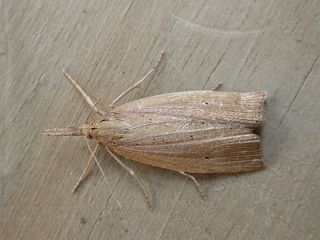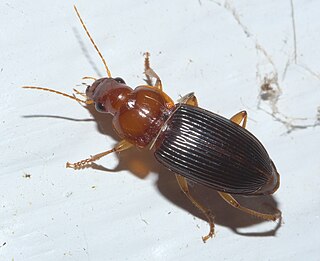
Victor Ivanovich Motschulsky, sometimes Victor von Motschulsky was a Russian entomologist mainly interested in beetles.

Sericoda is a genus of harpaline ground beetles. They are native to the Holarctic. Their habit resembles some members of the related genus Agonum, but they are generally smaller. The origin of Sericoda is apparently North America, with the Central American genus Elliptoleus the closest living relative.

The Photinini are a large tribe of fireflies in the subfamily Lampyrinae. Photinus pyralis is famous in biotechnology for its luciferase gene. This is sometimes employed as a marker gene; genetically modified organisms which contain it start to glow like the firefly when brought in contact with a luciferin-containing medium. Firefly luciferases differ slightly between taxa, resulting in differently colored light and other properties, and in most cases where "firefly luciferase" is used in some application or study, it is the specific luciferase of P. pyralis.

Harpalus is a genus of ground beetle first described by Pierre André Latreille in 1802.

Melyridae are a family of beetles of the superfamily Cleroidea.

Bembidion is the largest genus of beetles in the family Carabidae by number of species. All species are small and move very fast. Most of them live close to water. The genus has a biantitropical distribution, meaning they are found in both the Northern and Southern Hemispheres, but not in the tropics. In warmer regions it is substituted by closely related Tachys and other genera.

Chilo is a genus of moths of the family Crambidae. Some of these moths are called borers.

Cymindis is a genus of ground beetle native to the Palearctic, the Near East, and North Africa. It contains the following species:

Gymnodoris ceylonica is a species of sea slug, a dorid nudibranch, a marine gastropod mollusk in the family Polyceridae.

Platyninae is a subfamily of ground beetles.
Colobopsis ceylonica is a species of formicine ant. It is found from Sri Lanka.

Harpalini is a tribe of a diverse group of ground beetles belonging to the subfamily Harpalinae within the broader family Carabidae. The tribe contains more than 1,900 species.

Sericoda quadripunctata is a species of ground beetle in the family Carabidae. It is found in Europe and Northern Asia and North America.
Cricula ceylonica, the Sri Lankan cricula silkmoth, is a moth of the family Saturniidae. The species was first described by Karl Jordan in 1909 and it is endemic to Sri Lanka. The debate of this species with much broader range circular species - Cricula trifenestrata is not yet fully understood. However, Rougerie et al., in 2009 considered Cricula ceylonica a valid species, probably endemic to Sri Lanka.
Sericoda bogemannii is a species of ground beetle in the family Carabidae. It is found in North America and Europe.
Sericoda bembidioides is a species of ground beetle in the family Carabidae. It is found in North America.
Pagria is a genus of leaf beetles in the subfamily Eumolpinae. It is known from Africa, Asia and Australia.
Graphelmis ceylonica is a species of riffle beetle found in Sri Lanka.










